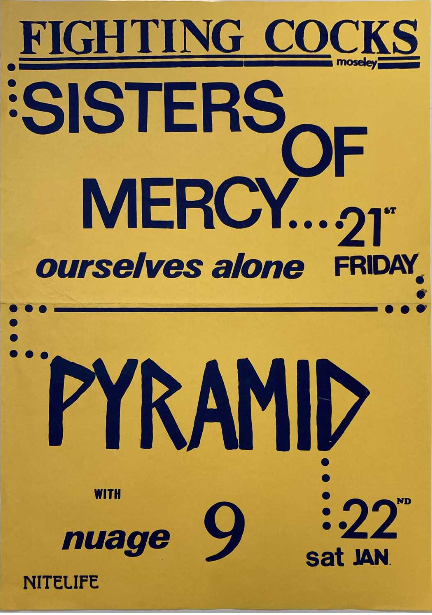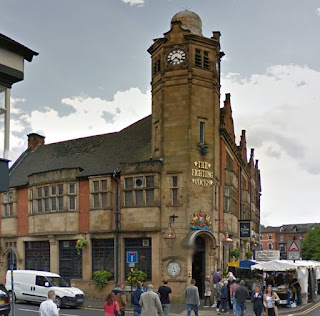Barely two months after the triumphant gig at the Fighting Cocks in suburban Moseley, TSOM were back in Birmingham once more on their March '83 mini tour, playing this time at the best known of the pub venues, the legendary Golden Eagle in Hill St in the city centre.
For a long time there was a lot of doubt as to
whether this gig took place at all. On Heartland Forum a decade ago, Dave R was
adamant that it didn't happen. "The Birmingham date was the Selly Park
Taven with the Wild and The Wandering (who became PWEI and the Stuffies) as
support. I know because I was there. The only Golden Eagle affair was when
Motörhead played the Demolition Party and a few Sisters were in their
entourage." (in the first part of his statement he is clearly referring to
the Bournbrook and to From Eden who became The Wild and The Wandering)
However, on other online Forums, others began to appear who had allegedly been at the gig, usually as part of a "Who did you see before they were famous?" thread, whilst a Songkick user stated that a band called Step Forward had been the support, an unusual detail for a "phantom" gig.
However, on other online Forums, others began to appear who had allegedly been at the gig, usually as part of a "Who did you see before they were famous?" thread, whilst a Songkick user stated that a band called Step Forward had been the support, an unusual detail for a "phantom" gig.
Within a month of each other two long-term fans
furnished me with a photo of the poster for the gig, first the ever-generous
uber-collector LG, whose copy is pictured above, and then, even more incredibly
a lady called Paula also got in touch, as it was her first TSOM gig and she too
had a copy of the same poster. Sadly, however, although she remembers having
been to the gig, she understandably couldn't recall any specific details alongside the many
other gigs which she attended in that era. Surprisingly, given the extent to
which TSOM gigs were being bootlegged as they began to dominate the indie
charts, no recording or photos have survived from the gig, which was the night
after the Liverpool and the night before the Colne gigs previously covered in
this blog. As can be seen from the rather informal poster ("two quid in"), the promoters (Nitelife) were the
same local enthusiasts who had put on the previous two gigs, this time
elevating the band to the biggest venue on their circuit, and which had a reputation (somewhat unusually given its city centre location) of being a bikers' pub at the time of the TSOM visit.
The Golden Eagle stood on the site of an earlier
pub, and was the pride and joy of brewers Holts when it opened in 1936,
redesigned by the architect FJ Osborne. With its polished black granite facade,
and metallic golden eagle motif by noted local artist William Bloye just above
what was originally the main entrance, the venue should have been a listed
building in its own right, not to mention its incredible musical heritage
stretching back to the 1960's. More recently to the TSOM gig, bands such as
Iron Maiden and U2 had stopped off there on early tours, playing the upper
floor music room which was only accessible via a steep and winding staircase,
on which local band 021 are posing in this contemporary photo from the
Birmingham Music Archive website. A member of the Birmingham History website
(going by the name of "The Purple Cow") remembers the venue well.
"It was a lovely, warm, atmospheric place with extraordinary Art Deco
internal architecture, fixtures and fittings. The journey to the men's loo was
particularly extraordinary, being a long subterranean journey along an
originally tiled corridor with authentic period light fittings and brass
handrails"
Generations of bands had lugged their
instruments and amps up and down these stairs, but eight months after the TSOM
gig the pub closed its doors for the pastime, condemned because of structural
faults which would have been difficult and expensive to fix for a pub with a
dwindling clientele, the post office having by now vacated the neighbouring
building. Apparently, not even the famed brass golden eagle plaque survived the
demolition, which was unsuccessfully fought by a pressure group determined to
keep one of the finest examples of Art Deco architecture in the West Midlands.
Like so many other demolished former gig venues,
the site of the Golden Eagle is now a car park, with no sign of its former
glory. TSOM's next visit to Birmingham would be of a much higher profile, the
legendary first gig with Wayne Hussey at the Tin Can/Fantasy club just over a
year later ...
(My thanks are due once again to those who have provided memories, photos and souvenirs of this gig, particularly Paula and LG on this occasion).











